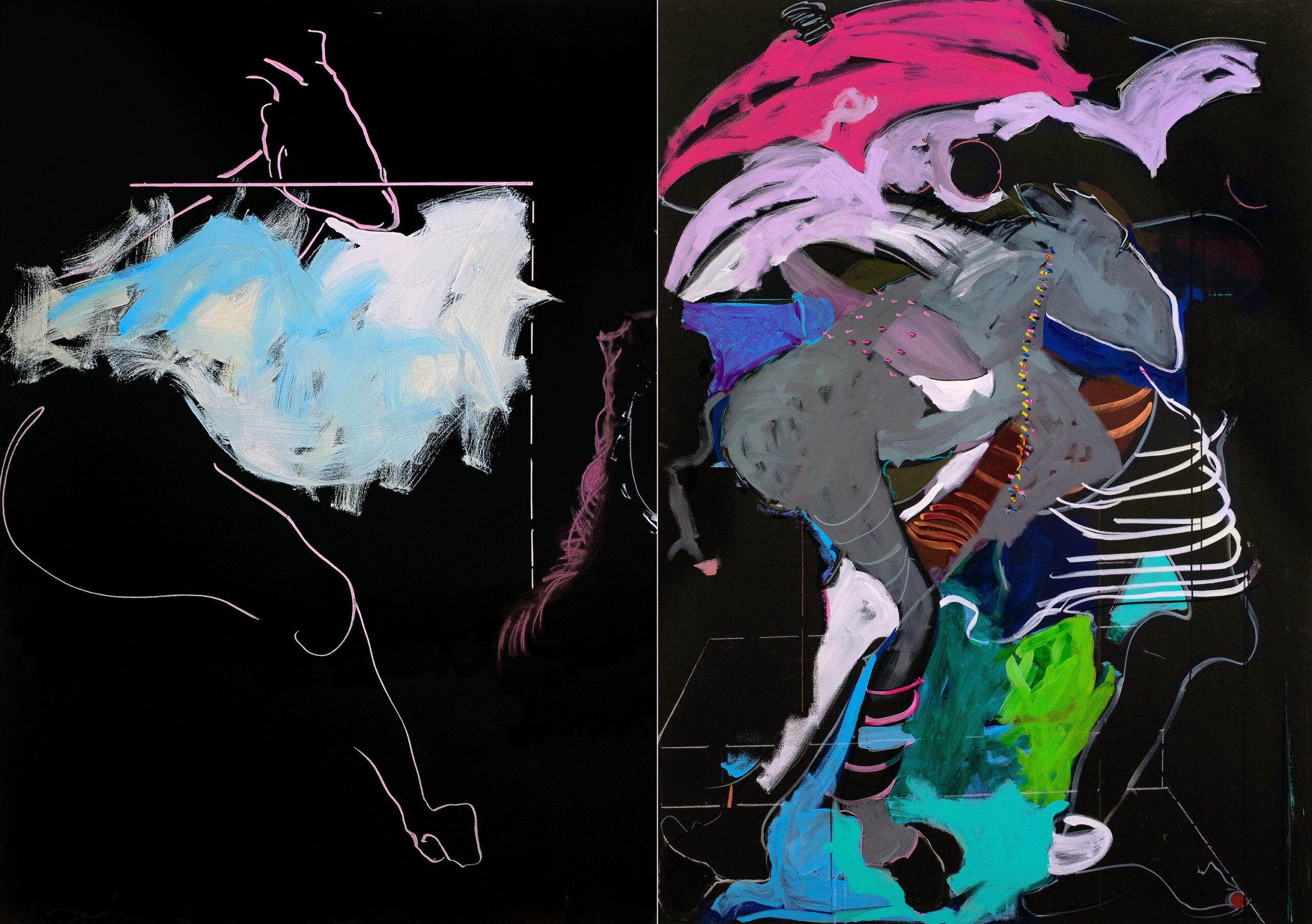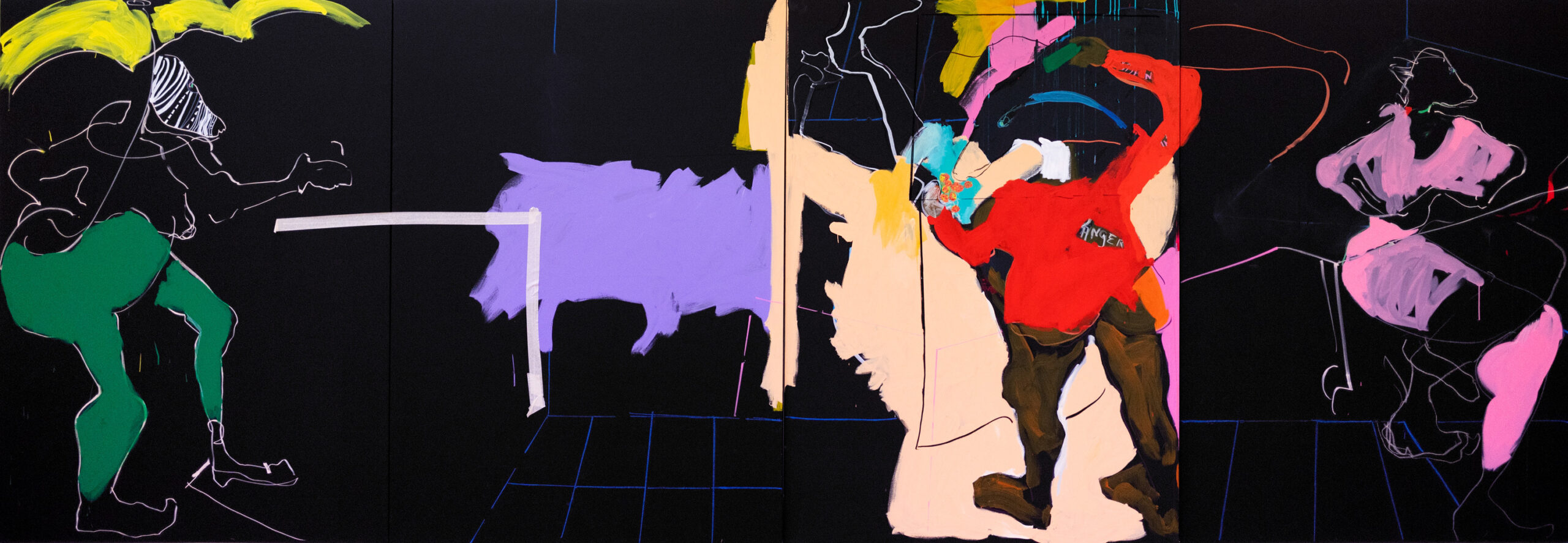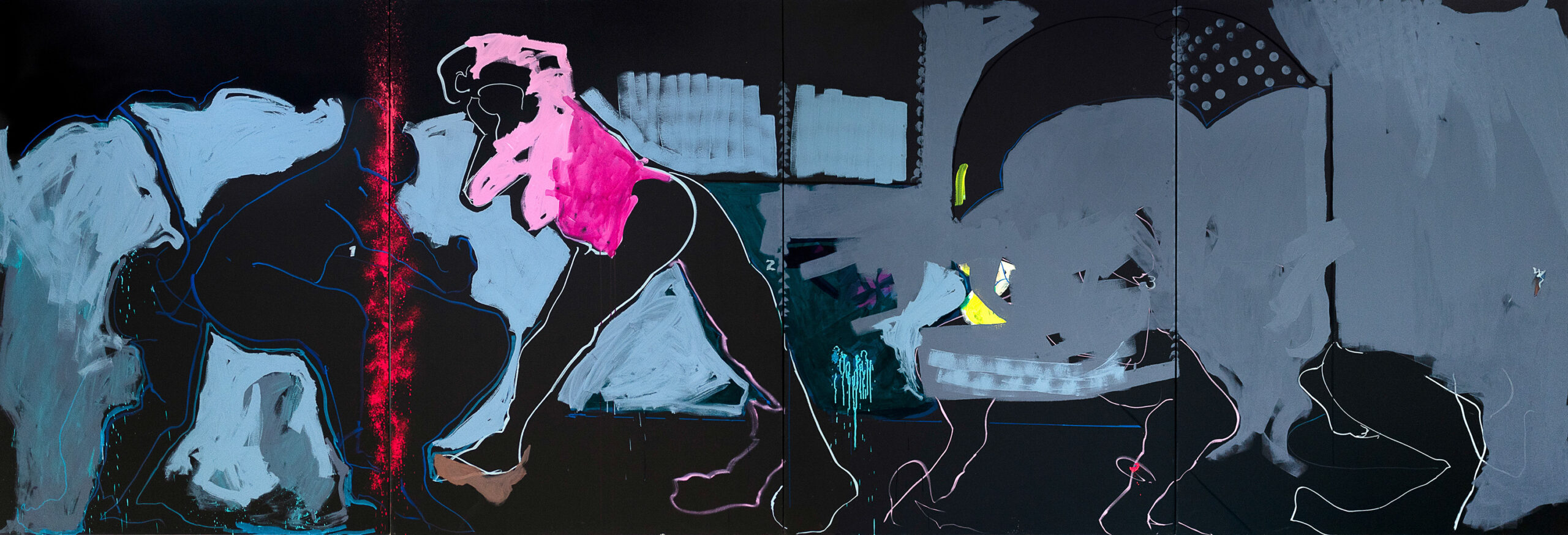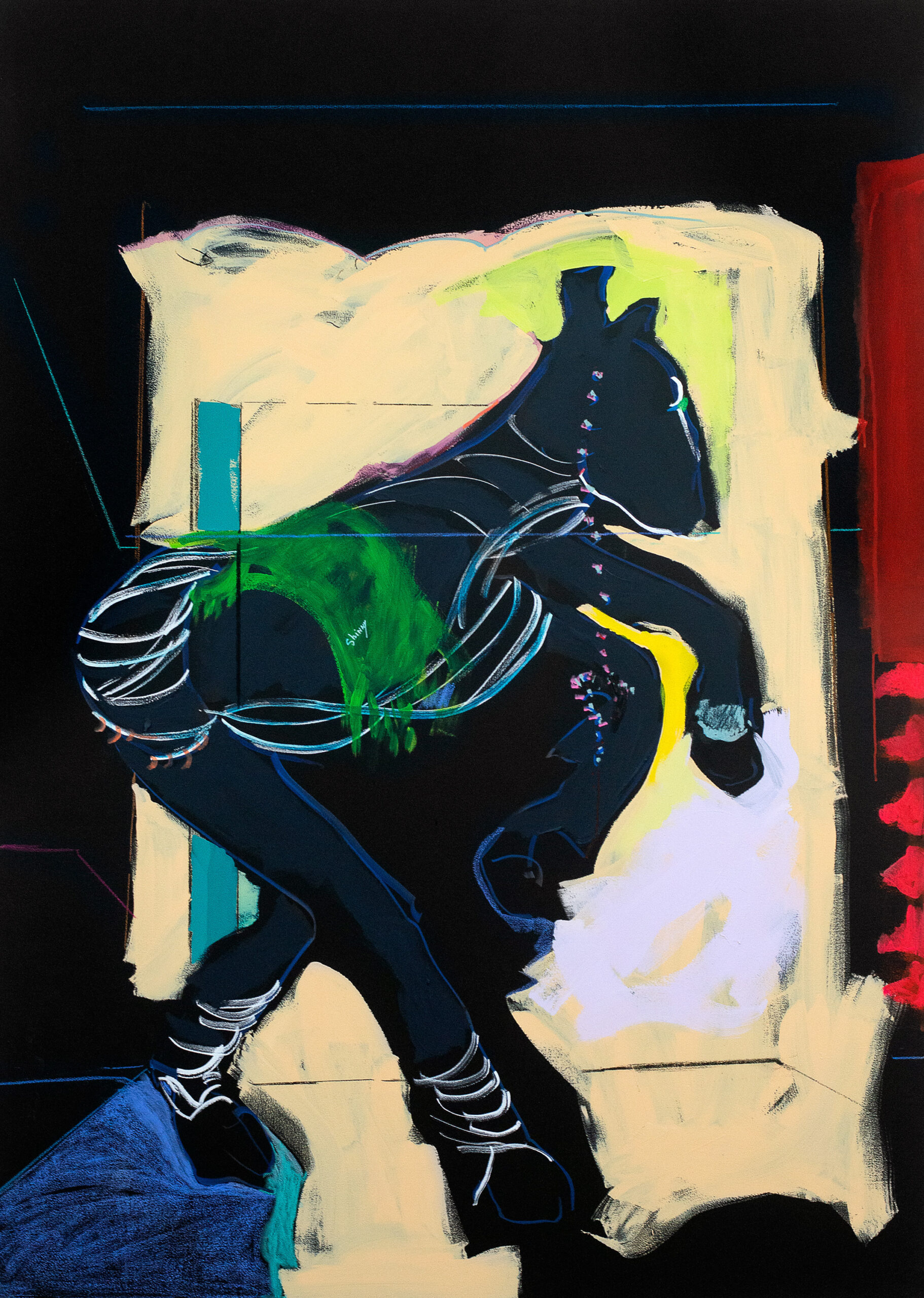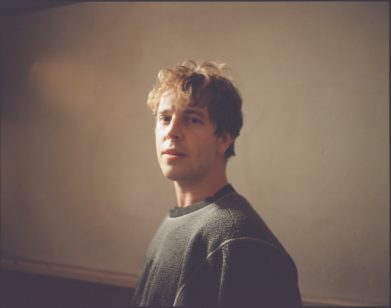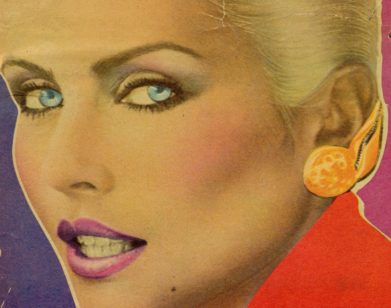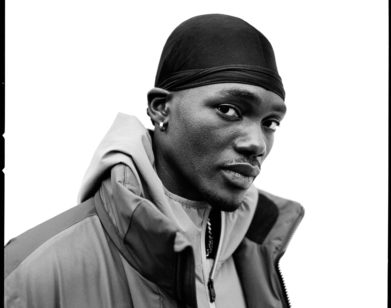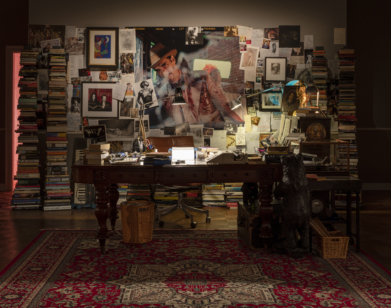OPENING
Mary Lovelace O’Neal Finds Interviews “Fucking Stupid.” But Not This One.
The other night, while water warmed on a stove at my friend Nash Glynn’s Seaport apartment, I picked up my phone and swaddled myself with custard-colored waffle blankets on a mattress. Ferns, orchids, monsteras, and peace lillies grew from every corner in her “garden room,” and I thought about displacement and being alone, about how the prefix “dis” married off to the word “placement” suggests a reversal or alteration of one’s sense of belonging or equilibrium. It’s more about place, or in this case, being in the right place at the right time. Phone in hand, I dial-touched a Mexican phone number. On the other end was the fuzzy voice of the artist and civil rights activist Mary Lovelace O’Neal, who’s just opened a new solo show of eerie, rhapsodic paintings at Marianne Boesky. O’Neal is a big one, and, she knows a thing or two about the right place, the right time. During our conversation, she recounted walking with a friend on the beach in San Francisco and seeing “these whales coming up and bringing up all of this water with them … like diamonds being thrown out across the sea.” Naturally, she added, “I started thinking about … how much water they must displace when they’re fucking?’” Probably tons.
Born in Jackson, Mississippi in the 1940s, drawing, painting, and other kinds of material resistance began the moment O’Neal was conceived. The South continued to be segregated by race and class. Displacement, enforced by law, prompted her family to relocate often. From a young age, her father gave her coloring books to keep her occupied on long train rides between towns. When she got off these trains with friends, O’Neal shared in a conversation with curator Jamillah James, they’d cause mischief by going into shops they likely weren’t allowed in and drank from whites-only faucets. Her thirst for both art and history took off: from a German expressionist curator and an early 20th century black and white collection at Tougaloo College, to peers like David Driskell, Lois Mailou Jones, and ex-boyfriend Stokely Carmichael, from the Black poets in Harlem to the minimalism of Donald Judd, an artist she adores for his ability to create an interior world purely of his own conviction, O’Neal mapped out everything she saw. Currently, O’Neal lives in Mérida, Mexico, where she shares a studio with two trusted companions, her cat and husband, Chilean painter Patricio Moreno Toro. Her practice dodges, or rather encircles, New York School abstraction, conceptualism, maximalism, even Parliament-Funkadelic.
At one point in our phone call, she tells me about a dinner in Paris with dear friends Carrie Mae Weems and Toni Morrison. Nina Simone was there, too. “John, I have never in my life, in my practice, as long as I have considered myself an artist, seen anyone react to my work like Nina did that day,” she recalled. “We couldn’t get her out of there.” I know the feeling: last week I revisited the Whitney Biennial where she has a few more paintings on view. I quietly sobbed in front of one for what felt like an hour. It’s easy to see why Ms. Simone was so transfixed.
———
JOHN BELKNAP: Hey, Mary.
MARY LOVELACE O’NEAL: Hi, Johnny. How are you?
BELKNAP: I’m pretty good. Last week, we turned the corner and now it’s spring. The buds on the trees have started to come out. There’s some cherry blossoms. You have three shows up currently, right?
O’NEAL: Yeah, at the Whitney Biennial, at Marianne Boesky Gallery, and then in San Francisco, so it’s a big time for me. It’s really exciting. I’m just sorry that my health is such that I’m not able to travel right now. I had surgery a while ago and it’s much more painful than I expected. But I do supermarket walking with my husband, I walk around with an empty basket and look at all the things I’ll buy later. I’m really trying hard to do what they tell me to do. But the physical therapists, they’re all just sadists. They push you to the breaking point. Anyway, I’m just sorry that I’m missing out on all of the excitement. I know that the Whitney was super crowded, and people came to my booth. My agent told me all kinds of wonderful things that people said. In some ways, I’m happy that I wasn’t there, because when people come up and tell you what they think about your pieces, you always have the sense that they’re just lying to you. But this way, they don’t have to lie. In fact, some things were super insightful that I didn’t even realize people could pick up on.
BELKNAP: What were some of those things that surprised you?
O’NEAL: They were almost spiritual things, like the energy [of the works]. Most people recognize that I’m obviously involved with color and line. That may be spoken about by other kinds of viewers like yourself, who are accustomed to reading art or painting. In the one called She Calls Herself Sahara, they could see puddles in the desert you might run across, little pastures of water. In the Atacama [Desert], we saw some really incredible things, like these flamingos that were pink. And that’s because they would eat pink shrimp that could be found in these little puddles of water. They could see the Andes in that particular painting. What happened in the Atacama for me was interesting, because it’s a very rough, rugged desert. And right after we were in Chile, we went to North Africa. And the Sahara is very different. It’s rolling and it’s soft, it’s voluptuous, so much of it, anyway. And it’s so biblical. You feel like if you walk around a mountain, Jesus is going to pop out, or Moses. That painting comes out of the desert series which was talking about straddling those two places. I loved doing that work and remembering both of those experiences. The people didn’t know about all of that, but they often brought things up like crucifixion. My agent told me that some of these people seemed to be really “mesmerized.” Anyway, I’m sorry. I didn’t answer your questions. I just started talking.
BELKNAP: That’s perfect. I love listening. We can talk for as long as you want.
O’NEAL: Okay. Ask me whatever you need.
BELKNAP: There’s a couple of different paintings there that span different periods of your artistic practice. What’s the story of the whales fucking?
O’NEAL: As they say, it ain’t deep. A friend and I were walking on one of the city beaches in San Francisco. At that point, I was teaching at the Art Institute. I was to the right of her, right next to the ocean, and there was something sparkling that drew my attention. And then, it happened again. It was these whales coming up and bringing up all of this water with them, so it was like diamonds being thrown out across the sea, because the sun was catching in that water. We were both thrilled, because it was during the time of year when whales go north. So I started thinking about them, like, “My god. Imagine how much water they must displace when they’re fucking.” It came to me like that. So I went to my studio in Oakland and the thought didn’t leave me. First, it started seeping into drawings. I was doing a lot of charcoal drawings that had to do with the work that started in graduate school. I might make 10, maybe even 15 black drawings in a day. But this whale energy started to come in there. I had found some packets of powdered pigment and I had fallen in love with using it, but in a very different way, boiling it with beeswax.
BELKNAP: I was reading about it, and it’s a really stable black and it renders things like acids and alkalis null and void. I also liked that it’s so literal, this black pigment is stable and this moment of discovery of the pigment and the whales displacing water provided you this sense of stability. Learning about the duality of your artistic practice, as well as your civil rights engagement and organizing, did you feel that literalness of stability?
O’NEAL: Let me talk to you a little bit about that lampblack itself, when I had to rub it into the fibers of the canvas. At one point, I was gessoing the canvas, and that really wasn’t working for me because I couldn’t get to the fiber. When it’s pure canvas, all of the fibers are exposed to me. And then, I could take this black stuff and rub it in. It is not stable, so when it wraps around the fiber, that’s it. That’s as flat and black as it can be. So when you see these paintings, they’re very seductive. You want to touch them because they’re like velvet. And because I was also working on big silver paintings, they ended up having some kind of glistening. From my compressor and spraying these other silver paintings, the overspray would somehow get caught onto those fibers in very delicate ways. With the painting at the San Francisco MOMA, that they bought for $.75, in 1979, but it’s up now. And it was in pristine condition when they unwrapped it.
BELKNAP: Was it that painting WHAT A WONDER? AKA, Untitled, No Title, Last Lay Up?
O’NEAL: I can’t remember right now. There’s so much in my mind these days and I’m trying to keep up with paintings. People ask me about specific things and I just can’t remember. I got a lot of shit in my head. I’m 82 years old, so I spit some out. You know?
BELKNAP: Yeah. I mean, person to person, what are some of the things that are on your mind, right now?
O’NEAL: I think about when I can get away and go to the beach and spend time over there and not spend time trying to remember all of this shit. It’s a funny thing, the minute we walk in that house, you can look straight through the house to the ocean. It’s almost like the breeze in the ocean comes in and cleanses almost instantly. All the work that I did getting those pieces done… I was in a lot of pain and unable to do what I used to, you know? Get up on my ladders and my chairs and bounce back and forth and stab the things and caress the paint. My whole practice has had to change. I end up whipping paint together in my lap as if I were making a cake. I make big pots of paint at one time so that I can dip from those. It’s not quite as spontaneous as the other stuff, because then I could practically squeeze out a big pound tube of paint on my table and just walk back and forth with it. Well, I can’t afford all of those steps. It’s all about who I used to be and who I am. I am just so thankful to god that I’m able to accommodate the practice. It happens in a different way, but it’s still very satisfying. Are you getting tired? Because I can go on and on, but I will get tired. My energy is fleeting. You’ll see how it is when you get to be 82. How old are your grandparents?
BELKNAP: All my grandparents are with us, but in a different way. They’re in the sky, or they’re in nature, or they’re not here.
O’NEAL: Reassigned?
BELKNAP: Exactly, they’ve been reassigned. My mother’s pretty old. She went to the hospital twice in the past week, so I totally hear what you’re saying. She has a lot of chronic pain, but I keep reminding her that just because the body’s changing, it doesn’t mean your brain or even your heart can’t be powerful.
O’NEAL: Yeah. When you finally accept that you’re not some diseased person.
BELKNAP: Exactly.
O’NEAL: Even if you end up with dementia of one sort or another, there comes a point when you can’t do anything about it. I get very nervous when I can’t think of something, but I’m really beginning to be quite at home with it. Where I come from, the old people used to say, “Well, it’ll come to you,” meaning that word that you can’t think of. And it’s the absolute god’s truth that it will come to you when you really need it. The pain is real. There are some ways to overcome it. You have to take pills. And some of the things are very disagreeable. But it also helps you manage.
BELKNAP: That makes a lot of sense. You talk a lot about mentors and friends, your family, your brothers, your parents. I love the story of when you went to Paris to see Toni Morrison and Carrie Mae Weems. And when you met Nina Simone and she was kind of the first person that really spent a lot of time with your work—
O’NEAL: John, I have never in my life, in my practice, as long as I have considered myself an artist, seen anyone react to my work like Nina did that day. We couldn’t get her out of there.
BELKNAP: Wow.
O’NEAL: She was there for at least two-and-a-half hours by herself going back and forth. We were making dinner for her and everybody was like, “Where is this woman? What is she doing?” Then I just decided I would leave her alone, because I’d never seen anything like it. There were two pieces dedicated to her. I have never seen anyone pay attention to the work in that way. It was absolutely fascinating. I tried to ask her what she was doing and she said, “Oh, I’m just looking.” She never gave up whatever it was that was drawing her attention. And at dinner, she never mentioned it again. She got involved with the other guests and was laughing and talking. It’s like she had not even been there.
BELKNAP: It must have meant a lot to her. Sometimes, you don’t even have to speak and you can feel a connection.
O’NEAL: Absolutely.
BELKNAP: I want to hear more about the new stuff you’ve been making.
O’NEAL: I would be happy to explore that. Because, sometimes, these—what do you call the, interviews?—are just fucking stupid.
BELKNAP: Yeah.
O’NEAL: In fact, I started telling a story that I had been born in Persia. You should try to look that one up.
BELKNAP: I will.
O’NEAL: I was born to a chief. I don’t want to get into it, because it is really involved and it’s funny and what have you. In fact, I had written it. I had gone to a different art school in the Bay Area to teach. I used to drive 500 miles a week. I would drive up to teach at Humboldt, which is in Northern California, logging country. I taught for a year up there. In fact, I was working on the work for the San Francisco MOMA, that ’79 show. I couldn’t find a studio up there big enough to do the work, so I had to drive back down to my Oakland studio to do the work on the weekends. I would teach two days a week and, depending on the time of that class, I would either drive back that afternoon or drive back on Friday. But, yeah, we can talk about some of those things. It’s really been nice and easy speaking with you.
BELKNAP: You too. I hope you have a nice night, Mary.
O’NEAL: I’ll look forward to it, honey.


